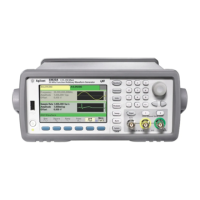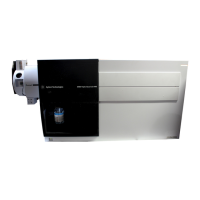108
Chapter 3 Features and Functions
Output Configuration
3
• For internally-modulated AM, FM, PM, and PWM, the Sync signal is
normally referenced to the modulating waveform (not the carrier) and
is a square waveform with a 50% duty cycle. The Sync signal is a TTL
“high” during the first half of the modulating waveform. You can set
up the Sync signal to follow the carrier waveform by using the
command:
OUTPut:SYNC:MODE {CARRier|NORMAL}
when modulating with internal modulation.
• For externally-modulated AM, FM, PM, and PWM, the Sync signal is
referenced to the carrier waveform (not the modulating waveform)
and is a square waveform with a 50% duty cycle.
• The polarity of the Sync signal may be inverted using the SCPI
command:
OUTPut:SYNC:POLarity {INVerted|NORMal}
• For FSK, the Sync signal is referenced to the “hop” frequency.
The
Sync signal is a TTL “high”
on the transition to the “hop” frequency.
• For frequency sweeps with Marker Off, the Sync signal is a square
waveform with a 50% duty cycle for the duration of the sweep. The
Sync signal is a TTL “high” at
the beginning of the sweep and goes
“low” at the midpoint of the sweep
. The Sync signal is synchronized
with the sweep, but is not equal to the sweep time because its timing
includes the re-arm time.
• For frequency sweeps with Marker On, the Sync signal is a TTL “high”
at the beginning of the sweep and goes “low” at the marker frequency.
You can change this behavior with the OUTPut[1|2]:SYNC:MODE
command.
• You can override normal sync behavior to force Sync to always follow
the carrier waveform. The command for doing this is called
OUTPut[1|2]:SYNC:MODE; see the Agilent 33500 Series
Programmer’s Reference Help for details.

